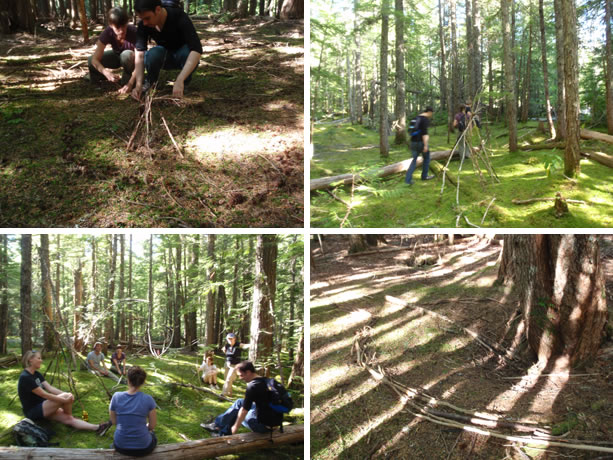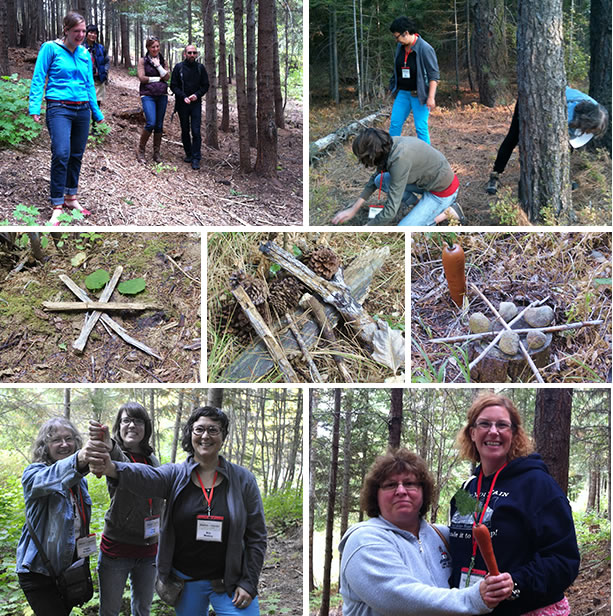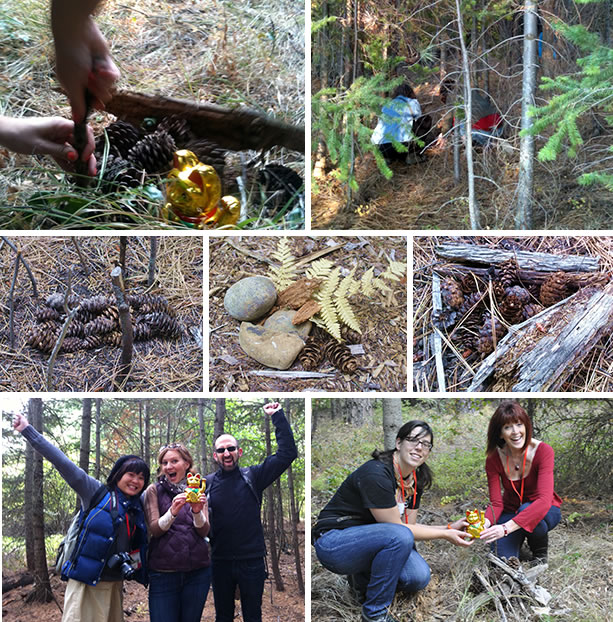As designers, we are regularly tasked with creating pathways for our intended audiences to follow in our design projects. Whether it’s a website that has products for sale or services to sign up for; or a brochure with an intended purpose, we create experiences with intended results.
As the current President of AIGA Portland, I was asked by the AIGA Seattle chapter to lead two outdoor workshops at their biennial “Into the Woods” design conference. I turned to a fellow AIGA Portland board member, Martha Koenig, and asked her to co-lead them with me. We had worked together on the chapter’s sustainability initiative for several years and are both obsessed with hiking and camping, so I knew we’d make a great team for this workshop.
After brainstorming a couple of ideas, we came up with a workshop concept based on wayfinding, taking it from the digital world we typically work in to an old-school analog experience. We determined that workshop participants would build some type of path for other participants to follow, and that they could only use the natural materials found in the area where the workshop takes place.

Since user testing is common on our website projects, we decided to use that methodology for this project also. So prior to the conference, we assembled two teams who used natural resources to create paths, then followed each other while they tried to determine where to go on the other team’s path.
We instructed them to create a total of five points that lead to a pre-determined object, with the start point and end point counting as two of the five. No words, letters, symbols or lines drawn as paths were allowed, and the participants were instructed to follow “leave no trace” principles.
We asked them to consider how scale, color, texture, pattern and placement could be used to create a path that a participant could follow. We also wanted them to consider how to plan for directional aides, using spacing effectively to make the path one that could be followed, while not making it too easy and allowing for a sense of discovery.
Each team was given a manufactured object to use as an easy-to-recognize end point. We selected a bright orange plastic carrot and a metallic waving cat, because we wanted to make sure the objects would stand out in the natural environment, and if they influenced the teams in any way, that was even better.

We ran our workshop test run on the Ramona Falls trail near Mount Hood. It was interesting to see how each team interpreted the assignment with a different approach. One team started building right away and determined the end point first, then worked back from there to the starting point, while the other team spent time discussing a plan before they got started and didn’t determine the end point until moments before their time was up.
The Beta Carrot Team created a visual language using circular shapes with openings for placing five sticks parallel to one another. The scale of each checkpoint varied greatly. Their first point was small with a teepee in the center, and the second was much larger and partially surrounded a tree. Another of their checkpoints placed the five sticks off the ground, leaning against a horizontal surface with a smaller circular pattern below them.
Team Golden Cat didn’t use pattern in the same way… each of their checkpoints was very different from each other. A large teepee of sticks with moss hanging from it led to a framed “portal” for participants to pass through, and the next checkpoint repeated the teepee but on a smaller scale.
After each team followed the other as they figured out where the checkpoints were and they found the objects at the end, both teams spent time discussing what they learned from the workshop experience.
We thought that we would need to refine our ideas and have the teams run through the process several times in order to learn what we wanted to do for the actual conference workshops. Instead, both teams exceeded our expectations of what we thought they would do and after a group debrief, we decided just to make a couple minor tweaks.

At the actual conference in Cle Elum, Washington, we gave the teams the same instructions used during the test run.
Again, each team took a different approach. Some began without much discussion, while one team determined where every point would be before gathering materials for building the checkpoints. It was interesting, however, that even though each group used a somewhat unique approach, the outcomes were consistently successful.
We had a lot of fun leading this workshop and learning from all of the participants. Many of them suggested that we should turn this into a regular event series, but with more time allowed so the teams could spend more time creating their paths. One participant suggested that the experience could be enhanced if we added an additional parameter, such as a word like “portal” to spur additional creativity.
If enough people express an interest in doing this workshop again, we’ll definitely consider it. Let us know what you think!